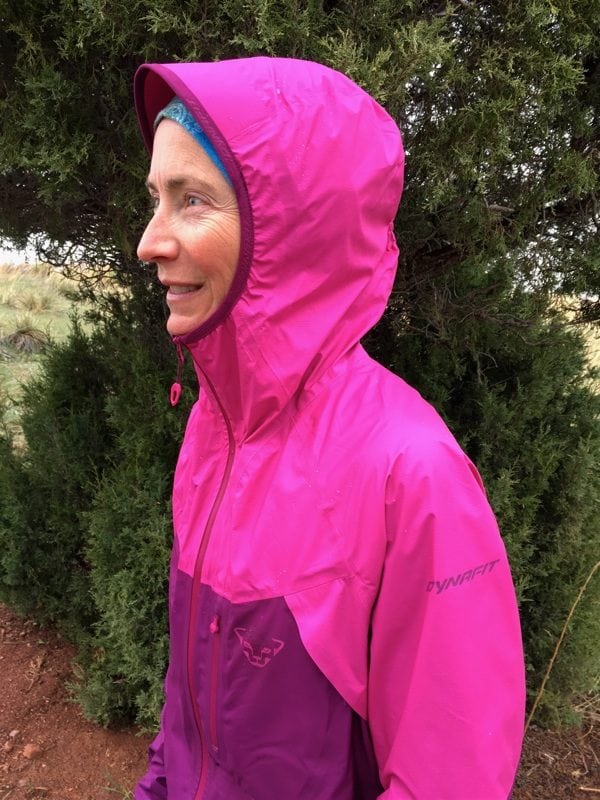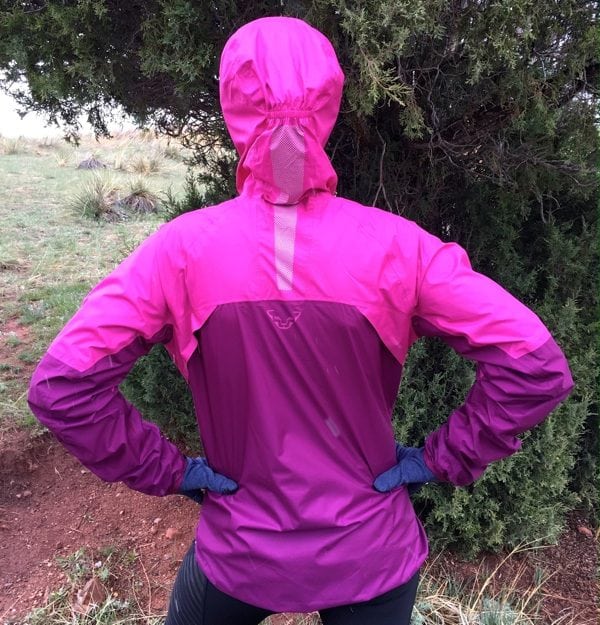Dynafit may not be the first company that pops into your head for very lightweight trail running gear unless you’re fully immersed in the European market or the world of skiing and ski mountaineering, but they’ve been proving their mettle in big mountains for years.
The 2016 update to the Dynafit Transalper Jacket Dyna-shell three-layer waterproof jacket ($250) is a minimalist-style shell that squishes easily into a hydration pack or stows into its hood if you prefer more “order” in your pack. (We’ll call this jacket the Transalper 2 going forward, as it’s easier and the jacket is being sold as such in some countries.) The technical specs state that the women’s jacket weighs in at 165g (5.8 oz) with a waterproof rating of 20,000mm and a breathability rating of 20,000g/m2. This meets the requirements of UTMB and many other mountain ultras while remaining exceptionally light for the performance and protection provided. As one might expect, you pay a bit of a premium for this level of performance at such a light weight, but when grams matter, this jacket is one of the best I’ve had the privilege to try.

The 2016 version of the Dynafit Transalper.
Wind Resistance
Forgive me as I wax poetic, but the Transalper 2 is a jacket worthy of flirting with the lenticular-like formations that swoop gracefully above the Rockies in the spring driving an icy 40-50 mph wind up and down the slopes. It would successfully ward off the bone-chilling winds seemingly of Canadian origin that sail through the plains of Nebraska and somehow manage to provide 30 mph headwinds in every direction you run. This 165g jacket functions like a garment twice its weight in the wind resistance department and yet is barely noticeable once it’s on. Obviously, this is not the jacket for 55+ degrees F with a light breeze, but when you’re heading for Mt. Washington and the Presidentials on a potentially blustery day—this Transalper 2 will live up to its name.
Waterproof/Breathability
As a waterproof/breathable jacket, I was thoroughly impressed. One of my harshest tests of these two qualities was on a 35-degree F day with wind-driven moderate rain mixed with sleet and icy pellets as I ascended and descended some Front Range trails for three hours. I wore a short sleeved poly-pro shirt and one lightweight wool long-sleeved hoody underneath and had no issues with warmth, sweating, moisture build up inside, or wetting out of the exterior. The taped seams showed no signs of leaking and the auto-lock, waterproof zipper kept the moisture out completely. This is in direct contrast to a 2.5 layer jacket of similar weight I recently wore for only two hours in 45 degrees F, moderate rain, and no wind—it soaked through to my under layers within 30 minutes.
The breathability of the Transalper is greatly enhanced by large angled vents on the lateral aspects of the jacket that facilitate airflow anteriorly, laterally, and posteriorly. I felt this concept greatly improved upon the old style of pit-zips because the lack of zipper saves weight and improves comfort and there is no gaping vent for water to enter. These vents lie flat but consist of a strip of the jacket fabric overhanging a perforated vent. It ranks as one of the best in terms of airflow in a “waterproof/breathable” jacket even when wearing a hydration vest. I did not get to run in a prolonged, heavy downpour as might happen in a lengthy thunderstorm or a soaker rain more common in other parts of the country, but unless I knew I needed a heavier waterproof for a particular reason, I’d easily rank this jacket in my top three for all of my single-day mountain excursions.

The Dynafit Transalper 2’s vents.
Highlighted Features
Hood: I think I’ve established, now, how much I appreciate my jacket hoods. This hood is partially fitted, courtesy of approximately three inches of elastic at the rear of the head instead of a pull cord. A large vertical reflective strip runs from this band of elastic to the upper back. A thin, soft, elasticized rim surrounds the hood which works in conjunction with a tall zipper ending at the chin to keep hood fitting snugly in the wind. It works surprisingly well despite the lack of pull-cord adjustments. The zipper does lack a protective “gutter” at chin, but I didn’t have any issues with chafing even when fully burrowed inside the jacket. Though the hood has a brim, it is overall of shorter front-back depth than the hood on jackets such as the Marmot Essence, the Ultimate Direction Ultra jacket, or a Patagonia Supercell. Specifically, this means that the hood doesn’t provide any “brim” protection if I have my hair in a ponytail and thus I wear a visor beneath if I want to keep precipitation out of my eyes. If you have short hair, wear your hair down, or perhaps have a less volumous head overall, you’ll likely not have this challenge. If you’re not a hood fan, it’s important to note that, as of yet, the Transalper hood has no stowage options when not in use. However, it doesn’t flap around like much thinner jackets.

The Dynafit Transalper 2 hood.
Fit: This is a challenging category to review at times since it’s very much a matter of personal preference. In my recent review of another jacket, I mentioned how much I loved their take on the women’s specific cut and the attached mitts. Dynafit has not chosen this route with the Transalper and it’s much more of a “unisex” and perhaps “cycling” style of fit. I found this fit a bit awkward for running, but it was not a deal breaker. The jacket I tested was a medium, which was just right in terms of arm length and overall mobility. The chest had plenty of room to fit over a pack with front water bottles, and I could pull my hands up into the sleeves on colder days. The soft elasticized wrists have no other adjustments (and no attached mitts), but they kept the wind and rain out adequately. The jacket’s long torso cut ends with a thin band of elastic at the bottom which hit at my greater trochanters and just below mid glute in the back if pulled all the way down. I liked the coverage overall, but as soon as I went uphill and used more hip flexion motion, the jacket tended to slide up to a narrower place. The stiffened waterproof zipper also resulted in uneven “folding” of the jacket as it moved up which resulted in two odd bulges over the chest and stomach area of the extra material. This was less of an issues if I had a pack on underneath.
Chest Pocket: True to the Transalper’s minimalist design, there is only one chest pocket with a waterproof zipper that easily fits the iPhone 6 in a baggie and yet doesn’t bounce around while running. The pocket is lacking a headphone port, but actually proved to be the most waterproof chest pocket of any jacket I’ve owned that wasn’t Gore-Tex.
Overall Impression
Despite my preferences for a different style of fit, I can honestly highly recommend this jacket for when three-layer protection is key yet you don’t want a 10-13 ounce jacket filling your pack. I’ve worn the jacket heavily in temperatures in the 40s Fahrenheit and below, with winds from 15-50mph, at altitudes from 5,000-13,000 feet, and in every type of precipitation that falls in Colorado between 20 and 48 degrees. This jacket has yet to allow any moisture in from the outside and does an outstanding job of venting any moisture I create. The Dynafit Transalper 2 delivers outstanding bad weather mountain and trail performance in a svelte, pleasant-to-wear package.

The rear of the Dynafit Transalper 2.
Call for Comments (from Bryon)
- If you’ve ever used Dynafit apparel, let us know how you fared.
- What’s your favorite lightweight waterproof jacket at the moment?
[Editor’s Note: If you’re leaving a comment regarding a product made by a company with which you’re affiliated (employee, ambassador, etc.), please share your relation in each of your comments on this article. Thanks!]
